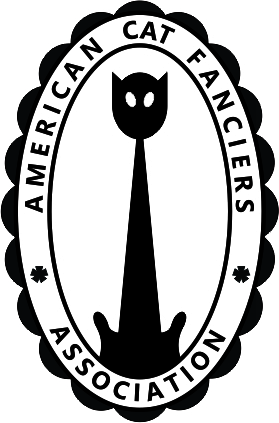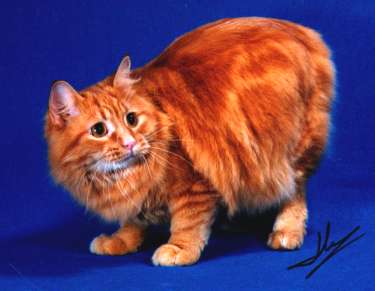 American Cat Fanciers Association
American Cat Fanciers Association
Cymric Breeders' Directory
~~~~~~~~~~~~~~~~~~~~~~~~~~~~~~~~~~~~~~~~~~~~~~~~~~~~~~~~~~~
The Cymric is the moderately longhaired version of the Manx. Except for the length of the fur, in all other respects, the two breeds are identical. Both breeds allow each other as out-crosses in ACFA and kittens are individually registered by hair length as to the breed. The Manx, a natural breed, originated on the Isle of Man, located in the Irish Sea, off the coast of Great Britain. Due to a mutation of the island's domestic cats, a strange tailless cat appeared. Over the years, the inter-breeding of tailless cats on the small island has led to this factor being a predominant gene among the cats.
According
to Marjan Swantek, author of The Manx Cat, published in 1987 by TFH
Publications, the longhaired gene was probably introduced to the
population by a Norwegian Forest Cat, brought to the island by King
Mangus of Norway.
The name Cymric (pronounced kim' rick) means Welsh; it was proposed
since many longhaired Manx were observed in Wales, at one time.
Initially, this name was used within all associations, but eventually,
in some associations, the breed is called simply, Long Hair Manx. In
ACFA, breeders have continued with the traditional name.
Their tail length classifies both Manx and Cymric cats. The ideal cat
is a dimple rumpy, in which there is a complete absence of a tail. When
gently touched, the total lack of a tail can be felt. The rumpy riser
has a small piece of bone or cartilage at the end of its spine; in a
relaxed state, this is not obvious. However, when excited, the rumpy
riser can lift this little cartilage in an up and down motion. Both the
rumpy and rumpy riser are eligible to be shown in championship classes.
Other kittens may have a stump of a tail; these are called stumpies or
stubbies. Still other kittens may have a full-length tail; some breeders
will dock their tails so that they appear to be stumpies. Both the
stumpies and tailed cats can not be shown in the championship classes.
It should be noted that all kittens are registered as either Manx or
Cymric, regardless of their tail length. In any given litter, there
might be any combination of the tail lengths. It should also be noted
that the tailless gene could be expressed too severely with the kitten
having spina bifida. These unfortunate kittens can not walk properly and
have bowel / bladder control problems. Most reputable breeders will have
these kittens euthanized as soon as the problem becomes apparent. The
tailless gene is a dominant gene which is lethal in the homozygous state
(i.e. the kittens do not develop in the uterus) so all tailless cats are
heterozygous. Because of the dominant nature of the gene, if a Manx or
Cymric were to mate with any other cat, it is possible for tailless
kittens to result; however, these are not considered to be pure-breed.
The double coat of a Cymric is a silky, medium length. When kittens
are born, the coat is not that much different from a Manx. But, within a
couple of weeks, the dense, plushy coat becomes obvious. A longhaired
kitten may result from the breeding of two shorthaired if both carry the
longhair recessive gene. If one parent is longhair, the kittens might be
longhair or shorthair. If both parents are longhair, the entire litter
will be longhair.
So, if one had two breeding cats (a Cymric and a Manx), it might take
several litters to produce one show quality Cymric kitten. In addition
to the tail status and hair length, other qualities that must be present
in a show quality kitten include: a short, stocky body, a rounded head
that is slightly longer than it is wide, a well-developed squarish
muzzle with prominent whisker pads, large round eyes set at a slight
angle downward toward the nose, tufted ears that when viewed from behind
resemble the rocker of a cradle, a deep broad chest, sturdy front legs
that are shorter than the hind legs, and a back that arches up in a
gradual curve from the shoulder blades to the haunches with a round
rump.
As household pets, these cats are superb. They tend to gravitate
toward one person in the household. They become, literally, your best
buddies. It is not unusual to find a Manx or Cymric in the lap of its
owner or resting next to the owner. They are playful and energetic.
Often, they will emit little trills of joy to be with you.
